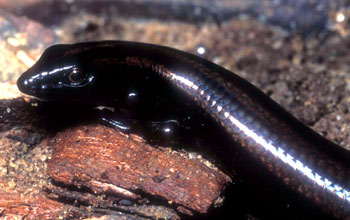Multimedia Gallery
New Lizard Species
New Lizard Species
A new lizard species from Borneo. The new kind of skink was discovered by Christopher Austin, assistant curator at Louisiana State University's Museum of Natural Science. Skinks are one of the most varied kinds of lizards, and tend to be glossy, with shorter legs and less noticeable necks than other kinds of lizards.
More about this Image
The jungles of Borneo are host to a wide array of animal and plant life. Borneo is well known for its mammals--it is the only place in the world where orangutans, elephants and rhinoceros can be found together. However, frogs, snakes and lizards are a critical component of the diverse array of tropical ecosystems in Borneo as well.
The island of Borneo accounts for less than one percent of the worlds land area but there are more than 423 species of reptiles and amphibians known from the island, accounting for about four percent of the world's frog, lizard and snake diversity.
Scientists predict that many more new species remain to be discovered in the inaccessible and poorly explored jungles of Borneo. In fact, during the last decade, 16 new species of reptiles and amphibians have been described, as well as more than 300 insects, plants and fishes.
Borneo is a treasure trove of biodiversity but wildfires and deforestation are major threats to Borneo's distinctive species. The Museum of Natural Sciences at Louisiana State University (LSU) is one of the largest natural history museums in the United States, with holdings of over 2.5 million specimens. The museum plays a crucial role in documenting, describing and cataloging the world's biodiversity. As the only comprehensive research museum in the south-central United States, the LSU museum fulfills a variety of scientific and educational roles for the state, nation and world. (Date of Image: 2005)
Credit: Christopher Austin, Louisiana State University Museum of Natural Science
Images and other media in the National Science Foundation Multimedia Gallery are available for use in print and electronic material by NSF employees, members of the media, university staff, teachers and the general public. All media in the gallery are intended for personal, educational and nonprofit/non-commercial use only.
Images credited to the National Science Foundation, a federal agency, are in the public domain. The images were created by employees of the United States Government as part of their official duties or prepared by contractors as "works for hire" for NSF. You may freely use NSF-credited images and, at your discretion, credit NSF with a "Courtesy: National Science Foundation" notation.
Additional information about general usage can be found in Conditions.
Also Available:
Download the high-resolution JPG version of the image. (4.1 MB)
Use your mouse to right-click (Mac users may need to Ctrl-click) the link above and choose the option that will save the file or target to your computer.



